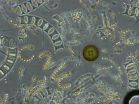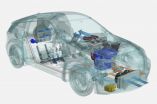INFORMATION:
Additional authors include David Almeida, professor of Human Development and Family Studies, and Susan McHale, distinguished professor of human development and family studies at Penn State; Katie Lawson, assistant professor of psychological science, Ball State University; Erin Kelly, professor of sociology, University of Minnesota; Rosalind King, health scientist administrator at the Eunice Kennedy Shriver National Institutes of Child Health and Human Development; Leslie Hammer, professor of psychology, Portland State University; Lynne Casper, professor of sociology, University of Southern California; Cassandra Okechukwu, professor of social and behavioral sciences, Harvard School of Public Health; and Ginger Hanson, research associate, Kaiser Permanente Center for Health Research.
The National Institute of Child Health and Human Development funded this study.
Improving work conditions increases parents' time with their children
2015-04-13
(Press-News.org) A workplace intervention designed to reduce work-family conflict gave employed parents more time with their children without reducing their work time.
"These findings may encourage changes in the structure of jobs and culture of work organizations to support families," said Kelly Davis, research assistant professor of human development and family studies.
The research is part of the Work, Family and Health Network's evaluation of the effects of a workplace intervention designed to reduce work-family conflict by increasing both employees' control over their schedule and supervisor behaviors that support employees' personal and family lives.
"The results show that we can change the way we work to improve family life," said Davis. "Our study shows that the workplace intervention had an effect on families by increasing parents' time with their children."
The Support-Transform-Achieve-Results (STAR) workplace intervention included training supervisors to be more supportive of their employees' personal and family lives, changing the structure of work so that employees have more control of their work time, and changing the culture in the workplace so that colleagues are more supportive of each other.
The researchers evaluated whether parents who participated in the STAR intervention reported significantly more daily time with their children compared with parents randomly assigned to a control group. They found that parents in the STAR group exhibited a statistically significant increase in parent-child shared time -- an additional 39 minutes per day on average -- between the pre-test and the 12-month follow-up post-test. By contrast, parents in the control group averaged 24 fewer minutes per day with their child at the 12-month follow-up.
"Our study tested ideas from the work-home resource model, which holds that work demands can deplete parents' resources, including their time and energy, with negative effects on their family functioning," Davis said. "By contrast, increasing work resources can increase the resources parents use in their family lives."
Work resources include supervisor support for personal and family life and flexible work schedules; parental resources include time available for children.
STAR affected mothers' and fathers' time with their children differently.
"Among the study's findings was that mothers' time with children increased more than fathers'," Davis said.
Interestingly, mothers in this sample did not work significantly fewer hours per week -- on average 46.24 and 46.59 hours per week for mothers and fathers, respectively -- and work hours did not significantly change from pre-test to post-test for either mothers or fathers. Thus, mothers may have been more inclined to take advantage of the opportunities and supports afforded by the Support-Transform-Achieve-Results intervention to spend time with their children.
The researchers argue that a healthy and satisfied employee can benefit the workplace by improving the business bottom line through more effective and efficient work. The findings are published today (Apr. 13) in Pediatrics.
ELSE PRESS RELEASES FROM THIS DATE:
Study finds emergency departments may help address opioid overdose, education
2015-04-13
(Boston) - Emergency departments (ED) provide a promising venue to address opioid deaths with education on both overdose prevention and appropriate actions in a witnessed overdose. In addition, ED's have the potential to equip patients with nasal naloxone rescue kits as part of this effort.
These findings are from a study published in the Western Journal of Emergency Medicine, and is the first study to demonstrate the feasibility of ED-based opioid overdose prevention education and naloxone distribution to trained laypersons, patients and their social network.
In ...
Gold by special delivery intensifies cancer-killing radiation
2015-04-13
PROVIDENCE, R.I. [Brown University] -- Researchers from Brown University and the University of Rhode Island have demonstrated a promising new way to increase the effectiveness of radiation in killing cancer cells.
The approach involves gold nanoparticles tethered to acid-seeking compounds called pHLIPs. The pHLIPs (pH low-insertion peptides) home in on high acidity of malignant cells, delivering their nanoparticle passengers straight to the cells' doorsteps. The nanoparticles then act as tiny antennas, focusing the energy of radiation in the area directly around the cancer ...
Mechanism outlined by which inadequate vitamin E can cause brain damage
2015-04-13
CORVALLIS, Ore. - Researchers at Oregon State University have discovered how vitamin E deficiency may cause neurological damage by interrupting a supply line of specific nutrients and robbing the brain of the "building blocks" it needs to maintain neuronal health.
The findings - in work done with zebrafish - were just published in the Journal of Lipid Research. The work was supported by the National Institutes of Health.
The research showed that zebrafish fed a diet deficient in vitamin E throughout their life had about 30 percent lower levels of DHA-PC, which is a ...
Pitt cancer virology team reveals new pathway that controls how cells make proteins
2015-04-13
PITTSBURGH, April, 13, 2015 - A serendipitous combination of technology and scientific discovery, coupled with a hunch, allowed University of Pittsburgh Cancer Institute (UPCI) researchers to reveal a previously invisible biological process that may be implicated in the rapid growth of some cancers.
The project, funded by the National Institutes of Health (NIH), is described in today's issue of the Proceedings of the National Academy of Sciences (PNAS).
"I was so amazed by what I was seeing," said lead author Masahiro Shuda, Ph.D., research assistant professor in Pitt's ...
Mystery of Rett timing explained in MeCP2 binding
2015-04-13
HOUSTON - (April 13, 2015) - For decades, scientists and physicians have puzzled over the fact that infants with the postnatal neurodevelopmental disorder Rett syndrome show symptoms of the disorder from one to two years after birth.
In a report in the Proceedings of the National Academy of Sciences, Dr. Huda Zoghbi and her colleagues from Baylor College of Medicine and the Jan and Dan Duncan Neurological Research Institute at Texas Children's Hospital, unravel the mystery by looking at when and how the causal gene involved (methyl-CpG binding protein 2 or MECP2) binds ...
Bacterial raincoat discovery paves way to better crop protection
2015-04-13
Fresh insights into how bacteria protect themselves - by forming a waterproof raincoat - could help develop improved products to protect plants from disease.
Researchers have discovered how communities of beneficial bacteria form a waterproof coating on the roots of plants, to protect them from microbes that could potentially cause plant disease.
Their insights could lead to ways to control this shield and improve its efficiency, which could help curb the risk of unwanted infections in agricultural or garden plants, the team says.
Scientists at the Universities of ...
Meteorites key to the story of Earth's layers: ANU media release
2015-04-13
A new analysis of the chemical make-up of meteorites has helped scientists work out when the Earth formed its layers.
The research by an international team of scientists confirmed the Earth's first crust had formed around 4.5 billion years ago.
The team measured the amount of the rare elements hafnium and lutetium in the mineral zircon in a meteorite that originated early in the solar system.
"Meteorites that contain zircons are rare. We had been looking for an old meteorite with large zircons, about 50 microns long, that contained enough hafnium for precise analysis," ...
Coexisting in a sea of competition
2015-04-13
Diversity of life abounds on Earth, and there's no need to look any farther than the ocean's surface for proof. There are over 200,000 species of phytoplankton alone, and all of those species of microscopic marine plants that form the base of the marine food web need the same basic resources to grow--light and nutrients.
A study by a team of scientists from the Woods Hole Oceanographic Institution (WHOI), University of Rhode Island (URI), and Columbia University, published April 13 in the Proceedings of the National Academy of Sciences reveals how species of diatoms--one ...
Network 'hubs' in the brain attract information, much like airport system
2015-04-13
ANN ARBOR, Mich. - One of the brain's main jobs is information processing - what is critical, however, is that information in the brain gets transferred to the right places at the right times.
Research on large-scale brain networks by the University of Michigan Medical School reveals that "hubs" in the brain - highly connected regions that like hubs of the airport system - tend to consistently attract information flow.
"Understanding how information transfer occurs in the brain is critical, especially if network hubs are taken off line by anesthesia, tumor or stroke," ...
Passenger-focused air conditioning
2015-04-13
This news release is available in German.
How can a pleasant vehicle climate be achieved efficiently? Researchers at the Technische Universität München (TUM) pursued this question in the context of the research project Visio.M funded by the German Federal Ministry for Education and Research (BMBF) with a total of 7.1 million euro. The results of their research show that the potential of energy efficient air conditioning is all but exhausted. And this applies also to gasoline powered cars.
Inefficiency has its advantages, too: In the past, waste heat ...


